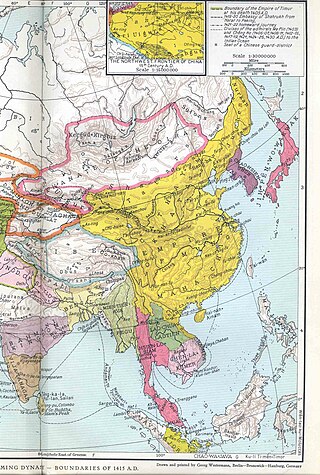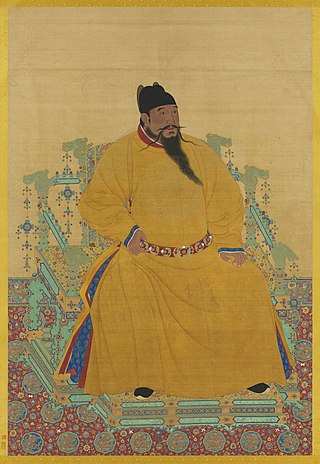Related Research Articles

The Ming dynasty, officially the Great Ming, was an imperial dynasty of China, ruling from 1368 to 1644 following the collapse of the Mongol-led Yuan dynasty. The Ming dynasty was the last imperial dynasty of China ruled by the Han people, the majority ethnic group in China. Although the primary capital of Beijing fell in 1644 to a rebellion led by Li Zicheng, numerous rump regimes ruled by remnants of the Ming imperial family—collectively called the Southern Ming—survived until 1662.

The Yongle Emperor, personal name Zhu Di, was the third Emperor of the Ming dynasty, reigning from 1402 to 1424. He was addressed as the "Emperor Manjushri" (文殊皇帝) by Tibetans.

The Hongwu Emperor, personal name Zhu Yuanzhang, courtesy name Guorui, was the founding emperor of the Ming dynasty of China, reigning from 1368 to 1398.
Hongwu was the era name of the Hongwu Emperor during his reign, and was also the Ming dynasty's first era name.

Khanbaliq or Dadu of Yuan was the winter capital of the Yuan Dynasty of Mongols in what is now Beijing, the capital of Zhongguo (China) today. It was located at the center of modern Beijing. The Secretariat directly administered the Central Region of the Yuan Dynasty and dictated policies for the other provinces. Kublai and his successors also claimed supremacy over the entire Mongol Empire following the death of Möngke in 1259. Over time the unified empire gradually fragmented into a number of khanates.
Köke Temür, sinicized name Wang Baobao, was a prominent general of the Yuan dynasty of China.
The Six Arts formed the basis of education in ancient Chinese culture. These were made and practiced by the Confucians.

Liu Ji, courtesy name Bowen, better known as Liu Bowen, was a Chinese military strategist, philosopher, and politician who lived in the late Yuan and early Ming dynasties. He was born in Qingtian County. He served as a key advisor to Zhu Yuanzhang, the Hongwu Emperor, the founder of the Ming dynasty, in the latter's struggle to overthrow the Yuan dynasty and unify China proper under his rule. Liu is also known for his prophecies and has been described as the "Divine Chinese Nostradamus". He and Jiao Yu co-edited the military treatise known as the Huolongjing.
Lan Yu was a Chinese military general and politician who contributed to the founding of the Ming dynasty. His ancestral home was in present-day Dingyuan County, Anhui. In 1393, Lan was accused of plotting a rebellion and put to death by the Hongwu Emperor. About 15,000 people were implicated in the case and executed as part of the Four Major Cases of the early Ming dynasty.

Xu Da (1332–1385), courtesy name Tiande, was a Chinese military general and politician who lived in the late Yuan dynasty and early Ming dynasty. He was a friend of the Hongwu Emperor, the founder and first ruler of the Ming dynasty, and assisted him in overthrowing the Mongol-led Yuan dynasty and establishing the Ming dynasty. He was also the father of Empress Xu, who married the third Ming ruler, the Yongle Emperor.

During the Yuan dynasty in the 13th century, there was a significant increase in the population of Muslims in China. Under the Mongol Empire, east–west communication and cross-cultural transmission were largely promoted. As a result, foreigners in China were given an elevated status in the hierarchy of the new regime. The impact on China by its Muslims at this time, including the advancement of Chinese science and the designing of Dadu, is vast and largely unknown. It is estimated that the population of the Hui minority grew from 50,000 in the 9th century to 4,000,000 in the 14th century, becoming the largest non-Han ethnic group.

The Ming dynasty, officially the Great Ming, founded by the peasant rebel leader Zhu Yuanzhang, known as the Hongwu Emperor, was an imperial dynasty of China. It was the successor to the Yuan dynasty and the predecessor of the short-lived Shun dynasty, which was in turn succeeded by the Qing dynasty. At its height, the Ming dynasty had a population of 160 million people, while some assert the population could actually have been as large as 200 million.

The Ming dynasty considered Tibet to be part of Western Regions or "foreign barbarians". The exact nature of their relations is under dispute by modern scholars. Analysis of the relationship is further complicated by modern political conflicts and the application of Westphalian sovereignty to a time when the concept did not exist. The Historical Status of China's Tibet, a book published by the People's Republic of China, asserts that the Ming dynasty had unquestioned sovereignty over Tibet by pointing to the Ming court's issuing of various titles to Tibetan leaders, Tibetans' full acceptance of the titles, and a renewal process for successors of these titles that involved traveling to the Ming capital. Scholars in China also argue that Tibet has been an integral part of China since the 13th century and so it was a part of the Ming Empire. However, most scholars outside China, such as Turrell V. Wylie, Melvin C. Goldstein, and Helmut Hoffman, say that the relationship was one of suzerainty, Ming titles were only nominal, Tibet remained an independent region outside Ming control, and it simply paid tribute until the Jiajing Emperor, who ceased relations with Tibet.

Yeheidie'erding, also known as Amir al-Din, was a Muslim architect who helped design and led the construction of the capital of the Yuan dynasty, Khanbaliq, located in present-day Beijing, the current capital of the People's Republic of China. According to Cary Y. Liu interpretation of the Ma-ho-ma-sha Stele inscription, either Amir al-Din's ancestors came from the Western Regions, although originating from Arabia, or that he directly came from Arabia.

Empress Renxiaowen, of the Xu clan, was the empress consort to the Yongle Emperor and the third empress of China's Ming dynasty. She was well educated, compiling bibliographies of virtuous women, an activity connected with court politics.

Empress Xiaocigao, commonly known as Empress Ma, was a Chinese empress consort of the Ming dynasty, married to the Hongwu Emperor and acting as his political adviser, exerting a large amount of influence during his reign.
The Prince of Ning rebellion was a rebellion that took place in China between 10 July and 20 August 1519 during the Ming dynasty. It was started by Zhu Chenhao, Prince of Ning and a fifth-generation descendant of Zhu Quan, and was aimed at overthrowing the Zhengde Emperor. The Prince of Ning revolt was one of two princely rebellions during the Zhengde Emperor's reign; it was preceded by the Prince of Anhua rebellion in 1510.

Li Shanchang was a Chinese politician of the Ming dynasty, part of the West Huai (Huaixi) faction, and Duke of Han, one of the six founding dukes of the Ming Dynasty in 1370. Li Shanchang was one of Emperor Hongwu's associates during the war against the Yuan dynasty to establish the Ming dynasty.

The Hongwu Tongbao was the first cash coin to bear the reign name of a reigning Ming dynasty Emperor bearing the reign title of the Hongwu Emperor. Hongwu Tongbao cash coins officially replaced the earlier Dazhong Tongbao coins, however the production of the latter did not cease after the Hongwu Tongbao was introduced. The government of the Ming dynasty placed a greater reliance on copper cash coins than the Yuan dynasty ever did, but despite this reliance a nationwide copper shortage caused the production of Hongwu Tongbao cash coins to cease several times eventually leading to their discontinuation in 1393 when they were completely phased out in favour of paper money. In the year 1393 there were a total of 325 furnaces in operation in all provincial mints of China which had an annual output of 189,000 strings of cash coins which was merely 3% of the average annual production during the Northern Song dynasty.
References
- ↑ Ebrey (1999), p. 191.
- Ebrey, Patricia Buckley (1999), The Cambridge Illustrated History of China, Cambridge: Cambridge University Press, ISBN 978-0-521-66991-7.